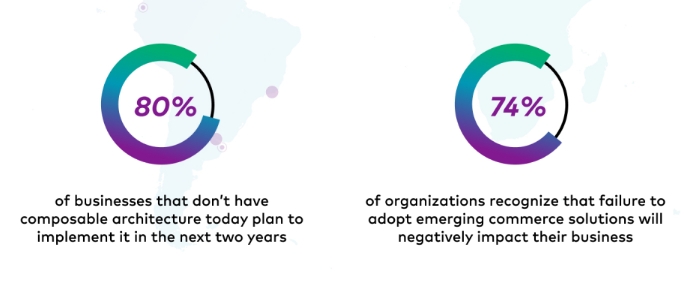Seamless, Risk-Free Shift to Composable

Source: 2022 State of Commerce report
The adoption of modern technologies is becoming increasingly critical for businesses to stay competitive in today’s fast-evolving digital landscape. This trend signals a strong move toward flexible, modular systems that allow companies to quickly adapt to changing customer demands and build fast, adaptable, and customer-centric digital experiences.
However, the journey to composable architecture is a daunting prospect for businesses that have been relying on legacy monolithic systems for many years. But it doesn’t have to be. This is where iterative migration comes into play.
What Is Iterative Migration?
Iterative migration is the process of gradually (incrementally) re-platforming a website. Usually, the process starts with a legacy monolithic website, and then iterative migration supports the rollout of a new, modern, headless website one page at a time.
The order in which pages are migrated may vary from business to business. As a rule of thumb, a company’s most valuable and high-traffic pages should move over first. These are typically pages that drive the most organic traffic, have high engagement or conversion rates and are crucial for SEO rankings.
In this scenario, an e-commerce business would typically start with product details pages (PDP) and then work backward to the product listing pages (PLP) search, and homepage.
The benefits of an iterative migration approach are numerous. When clearly understood and communicated, they can form the foundation of a compelling business case, making it easier for leadership to see the value and grant that all-important approval.
For companies planning to adopt a composable architecture, iterative migration offers a strategic, low-risk pathway to achieving their goals. Here’s why.
Minimized Risk and Disruption
The ability to minimize risk is one of the most significant advantages of iterative migration. In a composable architecture, using an iterative migration approach, pages are migrated one at a time meaning that businesses can isolate and address issues as they arise, without causing system-wide disruptions and ensuring business operations are not impacted.
Flexibility and Adaptability
Composable architecture is all about flexibility and iterative migration aligns perfectly with this principle. Because each page is migrated separately, businesses can easily assess how it integrates with the new architecture and adjust in real-time. Teams can pick and choose between different versions of pages on various platforms and dispatch live traffic to whichever they see as the best fit at any given moment.
Plus, users can start reaping the benefits of the new architecture early in the process, while the rest of the migration rolls out.
Reduced Time to Market
Another key benefit of iterative migration is the opportunity for continuous improvement. The migration process can start with the most crucial page, and live traffic can be dispatched to the new page as soon as it’s built. There is no need to wait for the entire website to be built before launching in one big and stressful event.
After each migration phase, businesses can gather feedback, evaluate the outcomes, and refine their approach for the next phase. Iterative migration allows for a more controlled, flexible, and efficient process, leading to a quicker deployment of new systems or features into the market.
Scalability and Future-Proofing
Composable architecture is designed to be scalable and adaptable, enabling businesses to respond quickly to changing needs and opportunities. Iterative migration supports this scalability by allowing businesses to gradually build and expand their new architecture.
As each page is migrated, it can be tested and optimized for future needs, ensuring that the final system is not only effective today but also ready to meet the challenges of tomorrow. This future-proofing is essential in today’s rapidly evolving technological landscape, where staying ahead of the curve is key to maintaining a competitive edge.
Confidence
Replatforming a website can be a challenging and stressful task. To make things worse, websites often have to be turned off for an extended period, losing revenue. With iterative migration, the new experience can be rolled only on a handful of URLs or even to a small portion of the traffic (more on this later), making migration much more manageable. This approach makes issue detection and mitigation much easier because the scope is smaller.
Better Stakeholder Management
Finally, iterative migration makes it easier to manage stakeholders throughout the migration process. By breaking the migration down into phases, businesses can provide regular updates on progress, building excitement and confidence in the new architecture.
Future-Proof Your Business: The Power of Iterative Migration
Iterative migration is a great technique that enables teams to bring value faster, be more flexible and release with great confidence.
And whilst replatforming might appear to be a significant undertaking, it doesn’t have to be overwhelming. By doing it iteratively, businesses can manage complexity, minimize risk, and ensure a smooth transition to a more flexible, scalable, and future-ready system.
In today’s fast-paced digital environment, the ability to adapt and evolve is crucial. Iterative migration provides a strategic, low-risk pathway to achieving a composable architecture that meets the demands of both today and tomorrow. Whether you’re just beginning your migration journey or are already well on your way, consider the benefits of an iterative approach to ensure your success.
Read how digital transformation partner KPS has leveraged Edgio’s iterative migration to spearhead the composable evolution for its clients.
To learn more about Edgio’s patented Iterative Migration approach, visit Edgio Sites.
 GigaOM Radar Edge Platform Leader & Outperformer 2024 |
GigaOM Radar Edge Platform Leader & Outperformer 2024 | 






